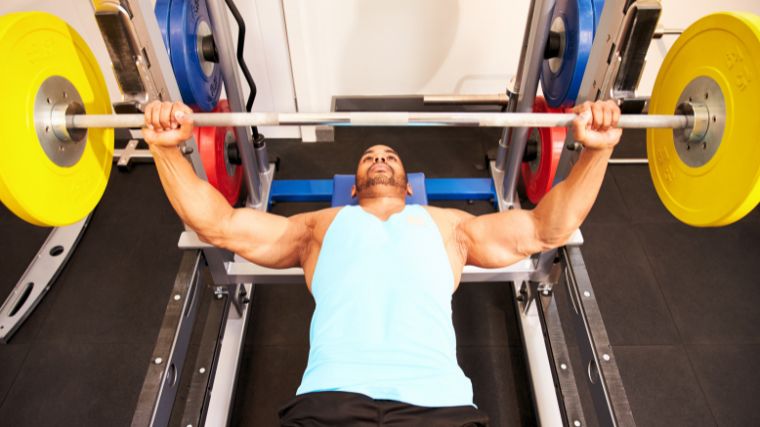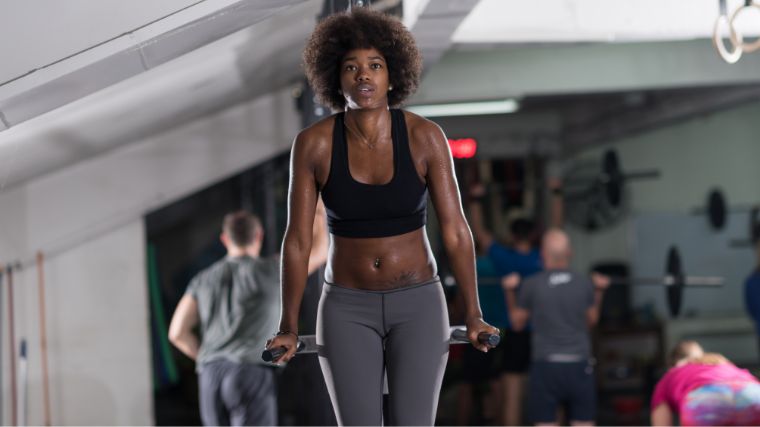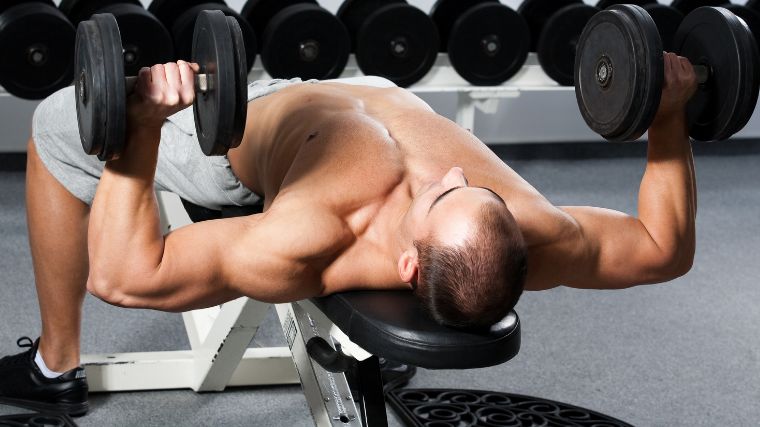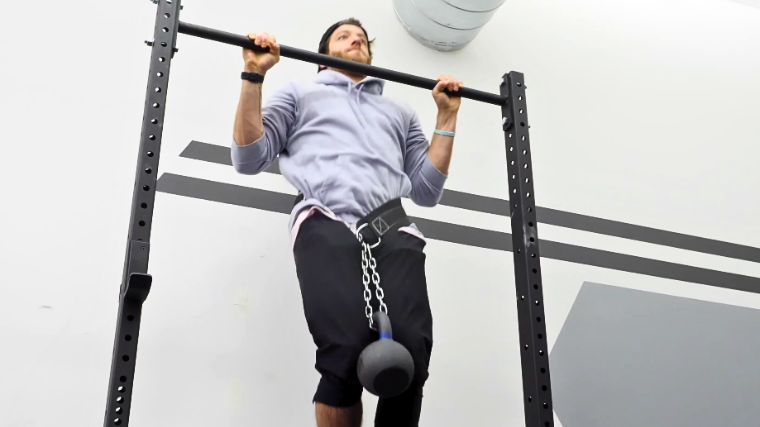There are certain exercises that live in your program for what seems like forever. Some progress easily or have a lot of variations that help delivering gains. Others feel like they slow to a crawl but you can still appreciate your hard earned progress. And then there’s the bench press.
The bench press is a universally-beloved exercise. Maybe you’re a powerlifter that needs it for competition, a bodybuilder looking for some diversity in your exercise selection, or just an International Chest Day devotee. In any case, you probably spend a good bit of time on the bench.

The bench press itself is a fairly straightforward exercise, but making consistent progress can get tricky. As you develop as a lifter, your skill, muscularity, or planning might need to improve to keep seeing gains. To avoid plateaus in your training, here are the best bench press workouts for your experience level.
- Best Bench Press Workout for Beginners
- Best Bench Press Workout for Intermediate Lifters
- Best Bench Press Workout for Advanced Lifters
Best Bench Press Workout for Beginners
If you’re just starting out, developing good technique in the bench press should be your main focus. Before the bench press can deliver huge strength or muscle benefits, you first need to dial in your execution.
In order to do that, your workouts should be designed around keeping you far enough away from failure to build good habits. From there, you can use accessory or supplemental lifts to build up your muscle.
The Workout
The bench press will lead your beginner workout. You’ll want to play it cool on the loading; it should be challenging, but still allow you to complete each repetition without technical breakdown. After that, pepper in some hypertrophy-style training and you’re set.
- Bench Press: 5 x 5
- Single-Arm Cable Row: 3 x 12
- Machine Pec Flye: 3 x 12
- Chest-Supported T-Bar Row: 3 x 10
- Cable Cross Body Triceps Extension: 3 x 15
Coach’s Tip: Finish each set of bench press with two or three repetitions in reserve.
Best Bench Press Workout for Intermediate Lifters
As an intermediate lifter, you’ve already gained a significant amount of skill in the bench press and, hopefully, mounds of muscle along with it. From here, changing up your workouts to integrate a few more dumbbells or loaded calisthenics will be very helpful.
[Read More: The Complete Guide to Pre-Workout Supplements]
This way, you’ll be hitting the muscles that still need to grow and get stronger, but also moving the needle on total-body strength and coordination as well.
The Workout
In terms of transfer to the bench press, a strong set of arms, shoulders, and back are almost always useful. Finding exercises that will challenge these muscle groups but also force you to stay tight and control your body will have a great carryover to the bench press.
You can also experiment with some variations or equipment that might be handy to swap once you progress begins to taper off.
- Bench Press: 3 x 3
- Incline Dumbbell Press: 2 x 10
- Dip: 2 x AMRAP
- Pull-Up: 3 x AMRAP
- Single-Arm Dumbbell Row: 3 x 10 per side
- Single-Arm Overhead Cable Triceps Extension: 3 x 15 per side
Coach’s Tip: AMRAP refers to “as many repetitions as possible.” Perform the set to true muscular failure.
Best Bench Press Workout for Advanced Lifters
As an advanced lifter, your strength in the bench press can be both an asset and a detriment. Depending on how heavy your bench press becomes, it can start to sap your overall energy for everything that comes after it in your workout.
Choosing a bench press variation that is challenging, has carryover to your main bench press, but uses less total load should be your goal. Once you’ve mastered the bench, turn your gaze toward your untapped potential elsewhere.
The Workout
There are many variations of the bench press that might be beneficial to you as you progress — your goal should be to choose the one that complements your sticking point. While this may be different for everyone, a close grip bench press is often a good place to start.
[Read More: The Best Foods for Energy Before, During, and After Your Workouts]
Treat the close-grip bench press with the same level of respect and intensity as your main bench press before hitting the remainder of your workout.
- Close-Grip Bench Press: 3 x 6
- Weighted Dip: 2 x 6
- Weighted Pull-Up: 2 x 8
- Single-Arm Dumbbell Row: 3 x 8 per side
- Standing Cable Flye: 3 x 12
- Single-Arm Overhead Cable Triceps Extension: 2 x 15 per side
Bench Press Variations
As you develop more experience, there is a high likelihood that the standard bench press might not service your goals. Although counter-intuitive, beginning to focus on bench press variations instead may be more beneficial. Some common variations are the close-grip bench press, Spoto press, Larson press, and incline bench press.
Close-Grip Bench Press
The close-grip bench press is a battle-tested bench press variation. It elongates your standard bench press range of motion and places a slightly different emphasis on your muscles (more triceps and more upper chest) throughout each repetition. By drawing your hands in a bit closer than your regular bench press grip, you can lower the weight on the bar and still experience significant challenges (and growth).
Don’t go crazy on grip width here, it doesn’t need to be a huge change. Shifting your hands an inch or so closer than normal is all you’ll need to get started. Avoid holding the bar any narrower than shoulder width.
Spoto Press
The Spoto press is another unique variation named after legendary powerlifter Eric Spoto. The Spoto press takes your normal bench press and strategically pauses about an inch off the chest, encouraging you to maintain constant tension throughout your body and challenging you in a common weak point.
[Read More: Nutrition for Athletes — How to Eat for Muscle and Performance]
You can use the Spoto press to develop better postural control and add some much-needed time under tension to your bench press workouts.
Larsen Press
The Larsen press is another variation named after a bench presser Adrian Larsen. The major key to a Larsen press is that you set up with your legs completely extended and not on the ground.
With this unique setup, you eliminate leg drive or stability from the equation, forcing you to complete each repetition with pure upper body strength alone.
Incline Bench Press
The incline bench press is a classic variation. When you use an incline to bench press your ability to stabilize the bar becomes a focal point of your success. Your full body tension, leg drive, and particularly shoulder stability will be big points of challenge because of the difference in your setup compared to the normal bench press.
You’ll also find that the incline bench press is a high-value variation; even lighter weights are tremendously challenging. As your pecs lose a bit of leverage, your ancillary muscles like the triceps and front delts need to pick up the slack.
How to Progress Bench Press Workouts
You aren’t always going to progress your bench press workouts just by benching more, or more often. Building muscle, tailoring your accessories to weak points, and adding in periodization are surefire ways to help out.
Build Muscle
Muscle mass is integral to performing well in tests of strength. The amount of raw tissue on your body can help in many ways, the most obvious being more muscle to actually lift the weights with, and more robust stability within the joint capsule of your elbow and shoulder.
[Read More: The 12 Best Supplements for Muscle Growth]
However, the more muscled you become, the more space on the bench you take up. As your back, chest, and arms grow, there will be a slight reduction in the range of motion needed to complete each repetition.
Tailor Your Accessories
Accessories are secondary exercises in your session that you typically perform after the bench press. They are designed to address weak parts of the bench press itself, such as your setup, bracing strength, lockout, or a specific sticking point. You should decide where to customize your exercise selection based upon where you struggle on the bench press.

Less experienced lifters may simply need to build muscle and train hard. However, to see continued progress – over time you will need to get more specific in your exercise selection.
Add Periodization
Periodization is the strategic modification of training variables such as sets, repetitions, and load in order to help drive long-term gains. Periodization is a mapped out route that has you plan your entire training program well in advance.
[Read More: Build a Titanic Torso with These Bodybuilding Chest & Back Workouts]
This kind of organization helps to direct your effort, but also has been shown to generate superior progress than non-periodized programs would. (1) Once you’ve established a decent level of skill, start to apply periodized programming to your bench press by following a pre-written plan, or enlisting the aid of a qualified coach.
What Muscles Are Worked in the Bench Press?
There are a ton of muscles at play for a successful bench press, many of which are often overlooked. The chest, triceps, shoulders, back, and even legs are major players in a strong bench press.
Chest
Your chest (or pectoralis major) is made up of a pair of fan-shaped muscles on the top half of your torso, just above the rib cage. On the bench press, your chest is responsible for helping draw your arm back towards your midline, which is the lion’s share of the biomechanical action during the bench press.
Triceps
No set of bench presses is complete until you fully lock out your elbows, which your triceps are specifically designed to do. The triceps are a triple-headed muscle group found on the back side of your arm.
When you lower the weight, your triceps lengthen to stabilize your elbow. On the concentric portion of each repetition, your triceps are called into action to close out each individual repetition by locking your elbows.
Shoulders
Your shoulders play an understated — but integral — role in your bench press performance. That said, your anterior deltoid (the front of your shoulder) actually performs much of the same role as your chest on the bench press. You can think of it as riding shotgun to the prime mover, your pecs.

Strong and robust shoulders will separate an average bench press from an exceptional one. You need good isometric strength to stabilize your scapula as you move through each rep on the bench.
Back
It may surprise you at first, but successful long term bench press progress is heavily reliant upon your back strength. Particularly, strength in your upper back. Once you are set up and locked into position, your traps and rotator cuff actively support the load. Without a strong upper back, you’d likely get pancaked by the barbell and flatten out on the bench.
Legs
Similar to the back, your legs can be an easily overlooked muscle group on the bench press. Your legs serve as an anchor once you’re all set up. In many ways, the legs will work synergistically with your back to avoid losing position during the bench press. Once you’re set up, your feet should be planted and you should use your legs to resist movement during the lowering part of each repetition.
[Read More: 5 At-Home Workouts for Strength, Muscle Growth, Power, and More]
Advanced lifters may also employ leg drive when testing their 1-rep maxes. Leg drive is a technique that helps generate pressing force by aggressively pushing your feet into the floor to transfer force from your lower body into your arms. If you can coordinate good leg drive, you will likely see a huge bump in your bench press progress.
Never Stop Benching
The bench press is one of those lifts that you constantly need to practice to see the most gains. You’re either developing technique and building muscle, adding brute strength, or looking for the secret sauce for your next personal record — but you’re always benching. Play with some variations and toss in periodization when you start to struggle, regardless of your experience level, there will always be a bench press workout for you.
References
- Williams, T. D., Tolusso, D. V., Fedewa, M. V., & Esco, M. R. (2017). Comparison of Periodized and Non-Periodized Resistance Training on Maximal Strength: A Meta-Analysis. Sports medicine (Auckland, N.Z.), 47(10), 2083–2100.
Featured Image: Monkey Business Images / Shutterstock
